VR fitness offers wheelchair users unprecedented exercise accessibility from home, eliminating physical barriers like gym access and travel challenges. You’ll enjoy customizable workouts tailored to your abilities, with real-time feedback reducing injury risk while strengthening upper body muscles. These immersive experiences boost motivation and combat the 56% inactivity rate among adults with disabilities. The mental health benefits are equally valuable, reducing anxiety and depression through engaging sessions. Discover how this technology is revolutionizing adaptive fitness right now.
Breaking Barriers: How VR Transforms Exercise Accessibility
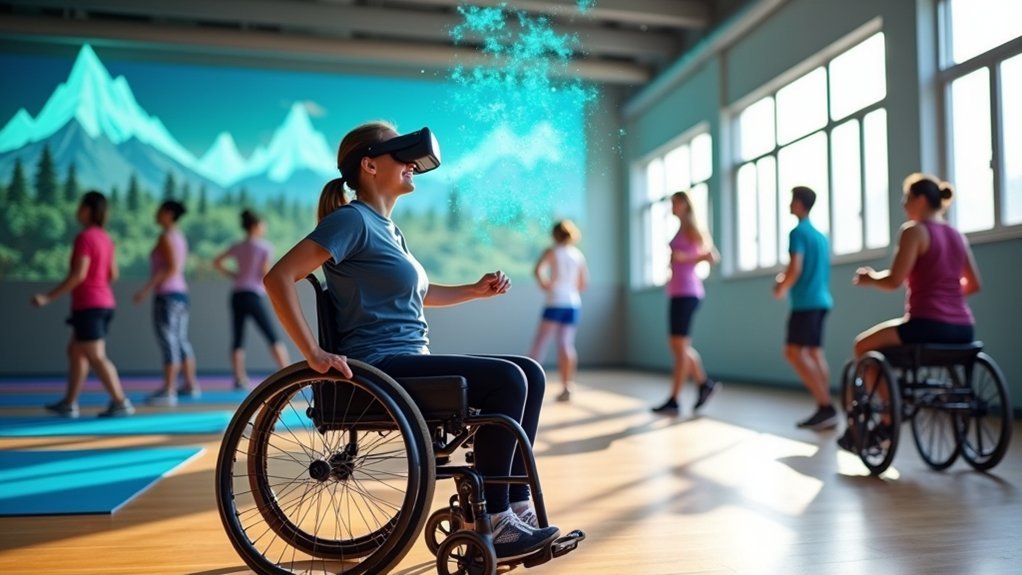
While traditional exercise settings often present significant challenges for wheelchair users, virtual reality is revolutionizing fitness accessibility.
You no longer need to worry about gym locations with inadequate wheelchair access or face the logistical hurdles of transportation.
VR fitness eliminates these physical constraints, allowing you to exercise comfortably from home without bulky equipment or dedicated space.
Exercise anywhere, anytime—VR fitness removes spatial barriers, making home workouts accessible without cumbersome equipment or special rooms.
This technology creates a private, judgment-free environment where you can work out without self-consciousness or external pressure.
What’s truly groundbreaking is how VR democratizes fitness regardless of your location or mobility limitations.
The technology adapts to accommodate your specific needs, providing tailored experiences that traditional gyms simply can’t match.
You’ll find freedom in a fitness approach designed with inclusivity at its core.
Research shows that VR-based exercise delivers results that are as effective as traditional workout methods while being more accessible to those with mobility challenges.
The Motivation Factor: Engaging Wheelchair Users in Daily Fitness
Despite compelling health benefits, wheelchair users face unique motivational challenges when establishing regular fitness routines.
You’re not alone if you struggle—statistics show 56% of adults with disabilities report no leisure-time physical activity, compared to just 36% of non-disabled adults.
Your motivation is heavily influenced by external factors. When physicians recommend exercise, you’re 82% more likely to participate.
Early success matters too; self-efficacy improves after short-term training, encouraging continued engagement.
Environmental barriers considerably impact your motivation. Limited accessible facilities, smaller city sizes, and safety concerns can diminish your drive to exercise.
Additionally, psychological barriers like lack of confidence affect your participation.
VR fitness provides a solution by creating accessible, engaging environments that bypass many traditional barriers while delivering the psychological benefits that keep you motivated.
Real Health Benefits Beyond Traditional Exercise Methods
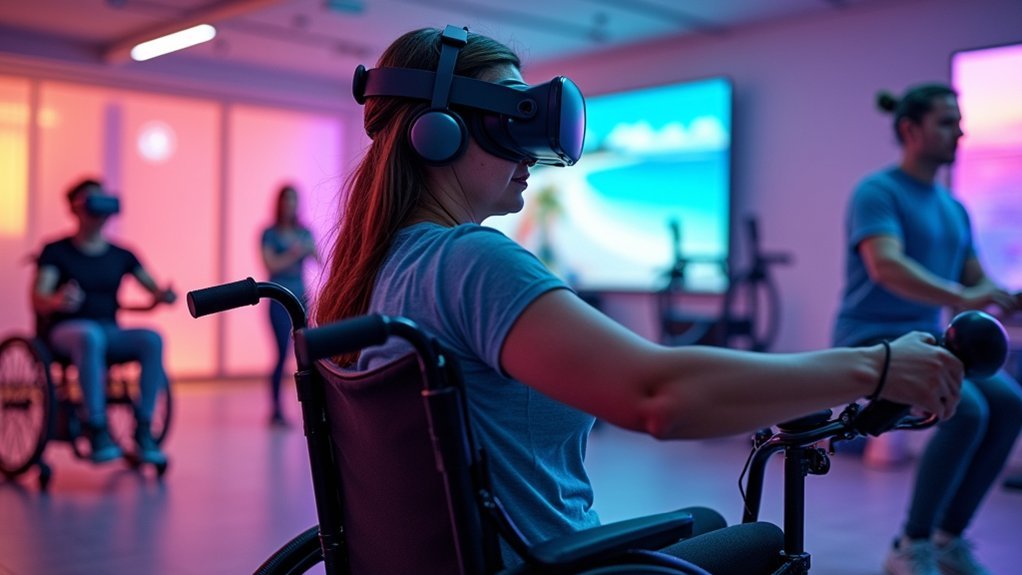
You’ll experience marked improvements in cardiovascular health through VR fitness, as these programs engage your upper body in ways traditional wheelchair exercises often miss.
Your stress levels will decrease considerably during immersive VR sessions that combine mindfulness with physical activity, creating a dual benefit for mental and physical wellbeing.
The customizable nature of VR workouts helps build muscle strength in targeted areas, allowing you to focus on specific muscle groups that enhance your daily mobility and independence.
Many VR games like Beat Saber can be played with one hand while seated, making them accessible fitness options for wheelchair users with varying mobility levels.
Improved Cardiovascular Health
Cardiovascular benefits stand out as one of the most significant advantages of VR fitness for wheelchair users. When you engage in VR exercises, you’ll maintain moderate intensity levels essential for heart health without the limitations of traditional workout methods.
Studies confirm that VR fitness sessions consistently elevate heart rates to beneficial zones, creating effective cardio workouts that can help prevent cardiometabolic diseases. You’ll experience improved blood pressure and metabolic markers through regular participation.
What makes VR particularly valuable is how it transforms necessary cardio work into engaging experiences. Rather than repetitive arm cycling, you’ll navigate immersive environments that keep you motivated while achieving the same health benefits.
This engagement factor leads to better long-term adherence—the key to sustaining cardiovascular improvements over time. Many wheelchair users are among the 47% of disabled individuals who are physically inactive, making VR fitness an especially crucial intervention for this population.
Reduced Stress Levels
While traditional exercise primarily targets physical fitness, VR workouts deliver considerable stress reduction benefits that extend far beyond conventional methods.
For you as a wheelchair user, this means experiencing the mood-boosting endorphin release of exercise in an engaging, distraction-filled environment.
VR fitness transforms your workout from a potentially stressful experience into an immersive journey that diverts attention from daily pressures.
Research shows VR exercise markedly reduces anxiety and negative mood states (p<0.001), offering accessible mental health support alongside physical benefits. Studies demonstrate that immersive virtual reality training can lead to decreased salivary alpha-amylase levels, a recognized biomarker of stress.
The cognitive engagement required in interactive VR scenarios further counters stress by fostering mental presence and clarity.
You’ll benefit from both physical activity and stimulating mental challenges that build resilience—making VR fitness a thorough stress-reduction tool perfectly suited for wheelchair users.
Enhanced Muscle Strength
Building muscle strength through VR fitness delivers substantial benefits for wheelchair users that extend far beyond traditional exercise methods.
You’ll experience targeted upper body workouts that can be customized to your specific needs and abilities without requiring expensive equipment or gym memberships.
VR’s immersive environments allow you to engage in strength-building exercises from the comfort of your home, eliminating transportation barriers and accessibility concerns.
Programs like FitXR offer boxing and sculpting workouts that effectively build muscle while tracking your progress over time.
The technology provides real-time feedback on your form, optimizing muscle engagement and reducing injury risk. Research shows that VR fitness can help those with mobility impairments reduce stress and anxiety while building strength.
These customized VR routines not only improve your physical strength but also enhance your cardiovascular health, balance, and motor skills—creating a thorough fitness approach specifically beneficial for wheelchair users.
From Bedroom to Virtual Gym: Exercise Without Leaving Home
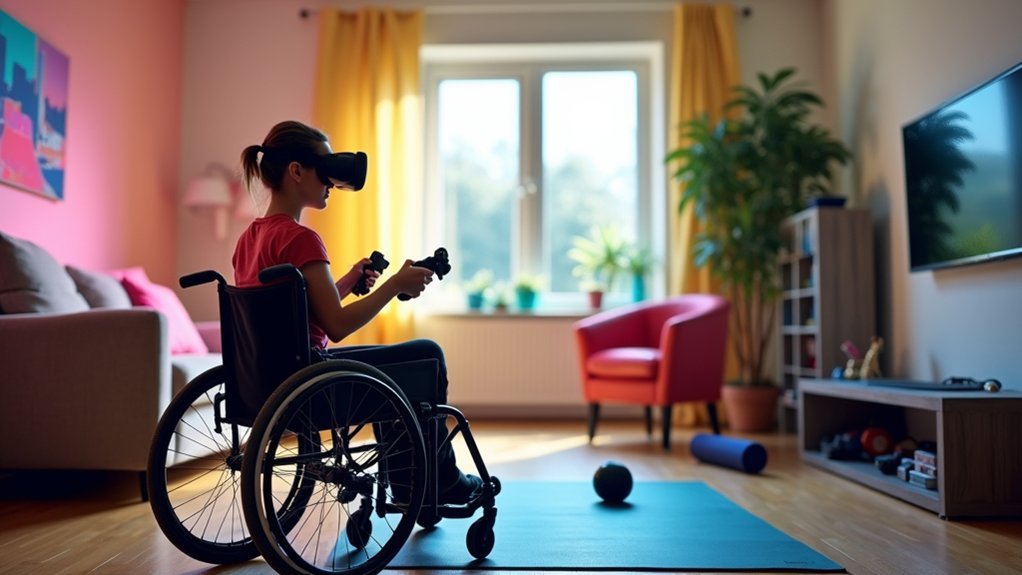
You’ll never have to worry about the commute to inaccessible gyms again as VR transforms your bedroom into a complete fitness center.
Rain, snow, or extreme heat won’t interrupt your workout routine when your exercise space exists in virtual reality.
VR training has shown promising results in enhancing skill transferability to real-life situations for wheelchair users, making it an effective addition to traditional training methods.
The controlled VR environment eliminates safety concerns that often prevent wheelchair users from attempting new physical activities in public spaces.
No Gym Commute Needed
For wheelchair users, the convenience of virtual reality fitness transforms exercise from a logistical challenge into an accessible daily routine.
You’ll skip the time-consuming process of traveling to accessible facilities, eliminating transportation barriers that often derail fitness plans.
Your bedroom or living room instantly becomes a complete gym with minimal space requirements.
All you need is your VR headset and controllers—no specialized equipment or facility memberships required.
This independence is revolutionary, allowing you to exercise safely on your own terms and schedule.
The flexibility extends beyond location.
You can create personalized health programs tailored specifically to your needs and abilities without maneuvering through often inaccessible traditional gym environments.
VR fitness puts complete control of your exercise routine literally within reach, whenever you’re ready.
This technology helps overcome the significant challenge of sedentary lifestyles that many individuals with disabilities face due to limited exercise options.
Weather-Proof Workout Solution
Weather presents a persistent barrier for wheelchair users seeking consistent exercise routines, but virtual reality fitness eliminates this obstacle entirely.
You’ll never again have to worry about icy sidewalks, flooded ramps, or scorching temperatures affecting your workout schedule.
VR creates a weather-independent fitness environment where you can maintain consistency year-round, regardless of what’s happening outside your window. This technology assists wheelchair users in regaining limb functionality through engaging rehabilitation exercises that would otherwise require specialized facilities.
- Seasonal Independence – Continue your fitness journey through winter storms or summer heat waves without interruption
- Time Flexibility – Exercise whenever works for you, not when weather permits
- Environmental Control – Enjoy perfect conditions every time, eliminating weather-related safety concerns
- Mental Relief – Remove the stress of planning workouts around unpredictable forecasts
Your fitness journey shouldn’t depend on Mother Nature’s mood swings – VR guarantees it never will.
Safe Space Guaranteed
Beyond weather concerns, accessibility challenges present another significant barrier for wheelchair users seeking regular exercise.
VR fitness transforms this reality by bringing a complete gym experience directly to your bedroom.
You’ll exercise in a safe, familiar environment where you control all variables. No more maneuvering through inaccessible facilities or feeling self-conscious about your abilities.
Your virtual workout space adapts to your specific needs and preferences, allowing you to exercise independently while reducing injury risks.
This personalized approach means you can focus entirely on your fitness journey without external stressors.
Many users report increased motivation when exercising privately at home, supported by family members when needed.
The psychological comfort of knowing you’re in a controlled environment often translates to better performance and more consistent workout routines.
Studies show that telehealth-based exercise programs like VR can significantly reduce social isolation for wheelchair users transitioning to adulthood.
Customized Fitness: Tailoring VR Workouts to Individual Abilities

Virtual reality fitness represents a groundbreaking frontier for wheelchair users, as today’s VR systems can be precisely calibrated to recognize and respond to individual movement patterns.
You’re no longer limited by traditional gym equipment designed primarily for standing users. This technology builds on the same principles that Fjord developed for empathy projects, aiming to provide meaningful experiences for individuals with mobility challenges.
These customizable VR environments work with your specific abilities and needs:
- Personalized Movement Recognition – VR technology identifies your unique wheelchair movements, translating them into meaningful in-game actions.
- Adaptive Difficulty Levels – Workouts automatically adjust based on your capabilities, ensuring ideal challenge without frustration.
- Sensory Accommodations – Visual and auditory elements adapt to your preferences and sensitivities.
- Targeted Exercise Focus – Games can concentrate on specific muscle groups you want to strengthen or mobility skills you’re developing.
The Mental Health Connection: VR Exercise and Psychological Wellbeing
While customizing VR fitness experiences addresses physical needs, the mental health benefits of these immersive workouts deserve equal attention.
As a wheelchair user, you’ll find VR exercise can greatly reduce anxiety and depression by creating engaging experiences that distract from daily challenges.
The immersive nature of VR provides a sense of control and deep engagement that directly improves psychological wellbeing. You’ll likely experience enhanced mood, reduced stress levels, and increased self-efficacy as you master gamified challenges. This boosts your belief in your abilities beyond the virtual environment.
VR workouts also offer cognitive stimulation, potentially improving cognitive function while reducing feelings of isolation. Recent research shows an impressive 90% adherence rate to VR exercise programs, demonstrating their long-term appeal and sustainability.
The first-person perspective intensifies these benefits, creating a holistic approach to fitness that enhances your overall quality of life beyond just physical improvements.
Building Community Through Virtual Reality Fitness Spaces
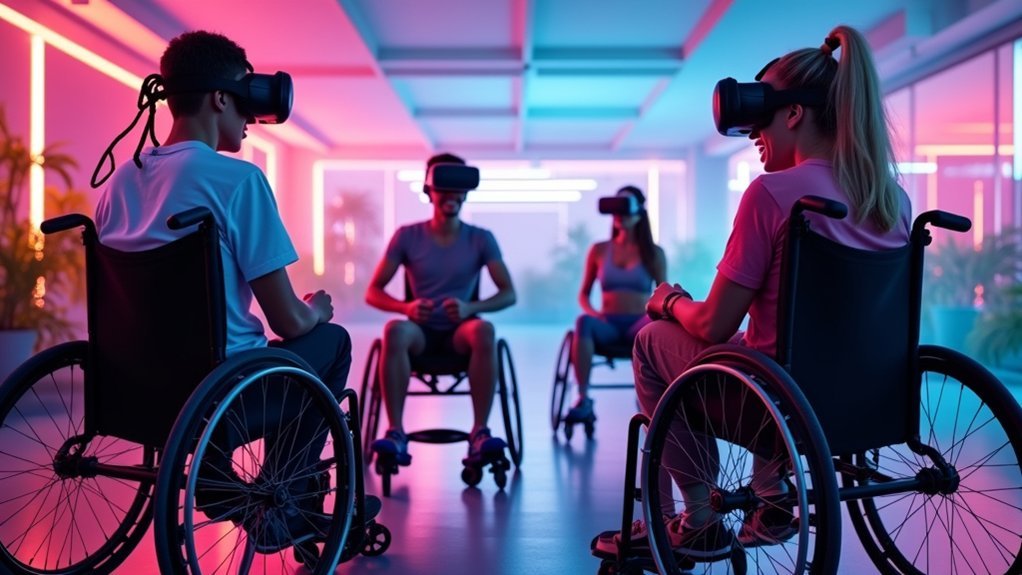
One of the most powerful aspects of VR fitness for wheelchair users extends beyond physical benefits to the creation of vibrant, inclusive communities.
In these virtual spaces, you’ll find yourself exercising alongside people from diverse backgrounds, all sharing similar fitness goals regardless of physical ability. With inclusive content development, 38% of VR fitness users are now women, highlighting the technology’s success in creating accessible spaces for traditionally underrepresented groups in fitness.
- Equal participation – Virtual environments level the playing field, allowing you to compete and collaborate without physical limitations defining your experience.
- Customized social interaction – Connect with others at your comfort level while adjusting sensory settings to match your needs.
- Competitive motivation – Engage in virtual competitions that boost your motivation through healthy rivalry and achievement tracking.
- Shared experiences – Build meaningful relationships through common challenges and victories, fostering a sense of belonging often missing in traditional fitness settings.
The Future of Adaptive Fitness: Where VR Technology Is Heading
As we look toward the horizon of adaptive fitness solutions, VR technology stands at the cusp of revolutionary advancements that will transform exercise possibilities for wheelchair users. You’ll soon experience fitness platforms specifically designed with inclusive principles that accommodate your unique needs. The continuous market growth predicted in the VR fitness sector by 2025 will likely accelerate development of wheelchair-accessible workout applications.
| Upcoming Technology | Benefit for You |
|---|---|
| AI-Powered Insights | Personalized workouts based on your mobility patterns |
| Haptic Feedback Suits | Feel realistic resistance without physical equipment |
| Advanced Motion Tracking | Precise upper body movement recognition |
The integration of biometric wearables with VR will provide real-time health metrics during your sessions. Meanwhile, lighter headsets are making extended workout sessions more comfortable. These technologies aren’t just enhancing accessibility—they’re creating entirely new fitness possibilities that weren’t available before, potentially improving both your physical wellness and mental health.
Frequently Asked Questions
What Equipment Modifications Are Needed for Wheelchair Users in VR?
You’ll need specialized seating like Rifton Activity Chairs, joysticks with VR tracking devices, customized controllers, and 3D-printed attachments. Your chair must be adaptable to accommodate your specific physical requirements for VR use.
How Does VR Fitness Compare Cost-Wise to Adaptive Gym Equipment?
VR fitness initially costs around $100,000 but only $115 per participant over three years. You’ll find it more cost-effective long-term than adaptive gym equipment, with minimal maintenance costs and less space required.
Can Caregivers Participate Alongside Wheelchair Users in VR Workouts?
Yes, you’ll find VR fitness creates perfect opportunities for caregivers to join wheelchair users during workouts. You can share virtual experiences, provide motivation, and participate in adaptive exercises together through user-friendly interfaces.
Are There VR Fitness Competitions Specifically for Wheelchair Athletes?
You’ll find few dedicated VR fitness competitions specifically for wheelchair athletes currently, though emerging platforms are increasingly incorporating adaptive features. Organizations like AbleGamers are beginning to advocate for more inclusive competitive VR spaces.
What Safety Precautions Should Wheelchair Users Take During VR Sessions?
During VR sessions, you’ll need to lock your wheelchair, keep space around you, avoid excessive twisting, use stable positioning, and monitor for discomfort. Take breaks regularly and stop immediately if you experience any adverse symptoms.
In Summary
You’re on the threshold of a fitness revolution designed with your needs in mind. VR fitness isn’t just a novelty—it’s an essential tool opening doors to exercise experiences previously unavailable to wheelchair users. As technology advances, your options will only expand. Don’t wait for the future to arrive; your pathway to more engaging, accessible, and community-connected fitness exists today.

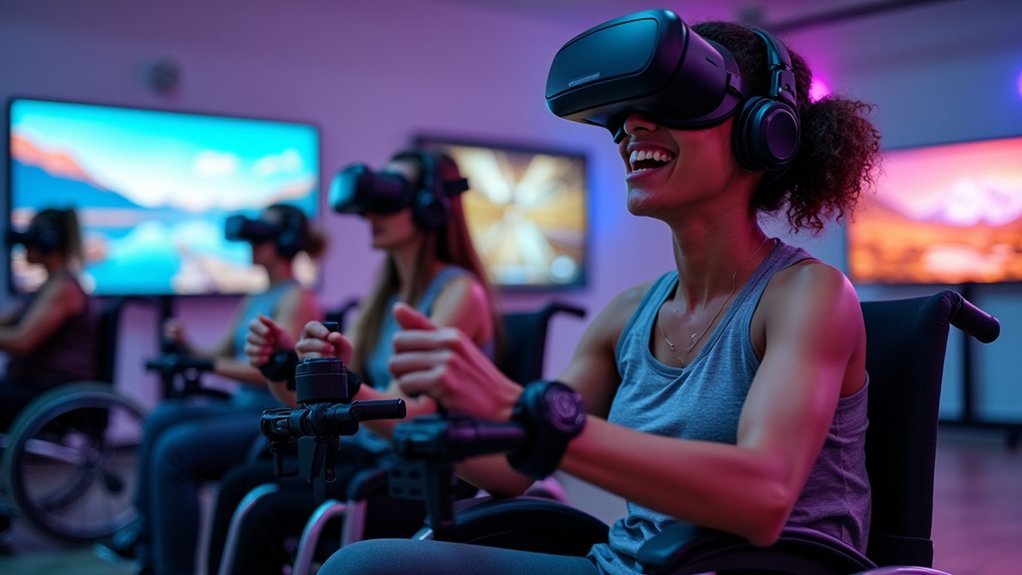



Leave a Reply